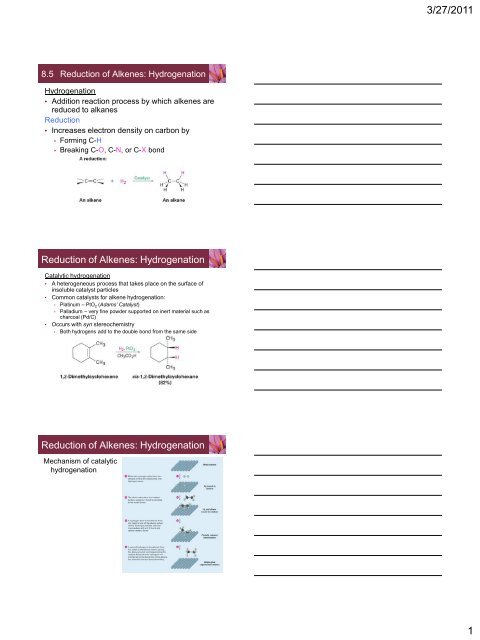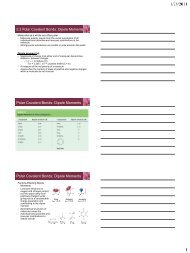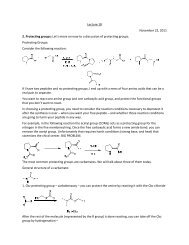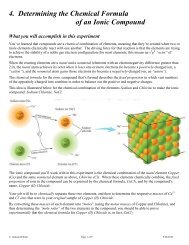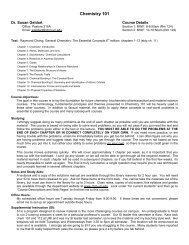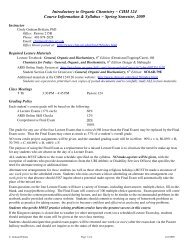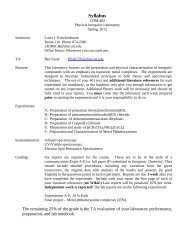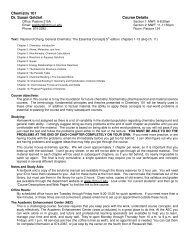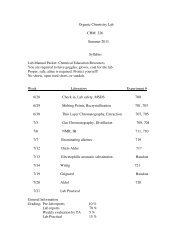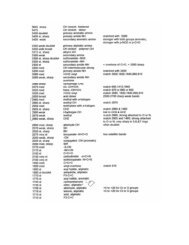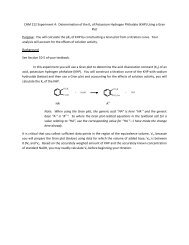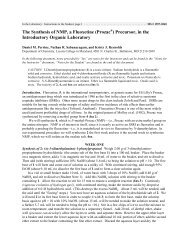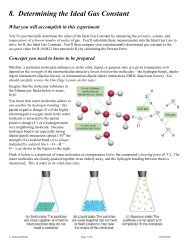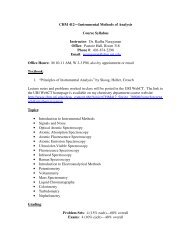Reactions of Alkenes and Alkynes
Reactions of Alkenes and Alkynes
Reactions of Alkenes and Alkynes
You also want an ePaper? Increase the reach of your titles
YUMPU automatically turns print PDFs into web optimized ePapers that Google loves.
3/27/2011<br />
8.5 Reduction <strong>of</strong> <strong>Alkenes</strong>: Hydrogenation<br />
Hydrogenation<br />
• Addition reaction process by which alkenes are<br />
reduced to alkanes<br />
Reduction<br />
• Increases electron density on carbon by<br />
• Forming C-H<br />
• Breaking C-O, C-N, or C-X bond<br />
Reduction <strong>of</strong> <strong>Alkenes</strong>: Hydrogenation<br />
Catalytic hydrogenation<br />
• A heterogeneous process that takes place on the surface <strong>of</strong><br />
insoluble catalyst particles<br />
• Common catalysts for alkene hydrogenation:<br />
• Platinum – PtO 2 (Adams’ Catalyst)<br />
• Palladium – very fine powder supported on inert material such as<br />
charcoal (Pd/C)<br />
• Occurs with syn stereochemistry<br />
• Both hydrogens add to the double bond from the same side<br />
Reduction <strong>of</strong> <strong>Alkenes</strong>: Hydrogenation<br />
Mechanism <strong>of</strong> catalytic<br />
hydrogenation<br />
1
3/27/2011<br />
Reduction <strong>of</strong> <strong>Alkenes</strong>: Hydrogenation<br />
Other unsaturated functional groups are much less reactive<br />
toward catalytic hydrogenation under normal reaction<br />
conditions.<br />
Reduction <strong>of</strong> <strong>Alkenes</strong>: Hydrogenation<br />
Hydrogenation<br />
• Unsaturated vegetable oils reduced to produce<br />
saturated fats used in margarine <strong>and</strong> cooking<br />
products<br />
• Vegetable oils<br />
• Triesters <strong>of</strong> glycerol, HOCH 2 CH(OH)CH 2 OH, with<br />
three long-chain carboxylic acids called fatty acids<br />
• Fatty acids<br />
• Polyunsaturated carboxylic acids containing long<br />
hydrocarbon chains<br />
• Double bonds have cis stereochemistry<br />
Reduction <strong>of</strong> <strong>Alkenes</strong>: Hydrogenation<br />
Catalytic hydrogenation <strong>of</strong> polyunsaturated fats<br />
2
3/27/2011<br />
Reduction <strong>of</strong> <strong>Alkenes</strong>: Hydrogenation<br />
Catalytic hydrogenation <strong>of</strong> polyunsaturated fats<br />
• Complete hydrogenation leads to saturated fatty acids<br />
• Incomplete hydrogenation results in isomerized trans fats that<br />
release trans fatty acids upon digestion, increasing blood cholesterol<br />
levels<br />
Biological hydrogenation (reduction) <strong>of</strong> isolated double bonds<br />
• Double bond must be adjacent to a carbonyl group<br />
• The reduction <strong>of</strong> isolated double bonds is rare in biological<br />
pathways<br />
• Process occurs in two steps<br />
1. NADPH (coenzyme reduced nicotinamide adenine dinucleotide<br />
phosphate) adds hydride ion (H: - ) to double bond to produce an<br />
ion<br />
2. Protonation <strong>of</strong> an anion by acid HA leading to an overall addition<br />
<strong>of</strong> H 2<br />
Reduction <strong>of</strong> <strong>Alkenes</strong>: Hydrogenation<br />
Biological reduction <strong>of</strong> double bond in trans-Crotonyl<br />
ACP leads to the formation <strong>of</strong> Butyryl ACP<br />
8.6 Oxidation <strong>of</strong> <strong>Alkenes</strong>: Epoxidation<br />
Oxidation<br />
• A reaction that results in a loss <strong>of</strong> electron<br />
density by carbon<br />
Oxidation<br />
• Decreases electron density on carbon by<br />
• Breaking C-H bond<br />
• Forming C-O, C-N, or C-X bond<br />
Note: oxidation <strong>of</strong>ten adds oxygen; reduction <strong>of</strong>ten adds hydrogen<br />
3
3/27/2011<br />
Oxidation <strong>of</strong> <strong>Alkenes</strong>: Epoxidation<br />
<strong>Alkenes</strong> on treatment with a peroxyacid, RCO 3 H, are<br />
oxidized to give epoxides<br />
Epoxide (oxiranes)<br />
• Cyclic ethers with an oxygen atom in a three-membered<br />
ring<br />
Oxidation <strong>of</strong> <strong>Alkenes</strong>: Epoxidation<br />
Synthesis <strong>of</strong> epoxides from alkenes<br />
• Peroxyacid transfers oxygen to alkene<br />
• Syn stereochemistry<br />
• Both C-O bonds form on the same face <strong>of</strong> the double<br />
• One step mechanism<br />
• No intermediates<br />
Oxidation <strong>of</strong> <strong>Alkenes</strong>: Epoxidation<br />
Synthesis <strong>of</strong> epoxides from halohydrins<br />
• Preparation <strong>of</strong> halohydrin through electrophilic addition <strong>of</strong><br />
HO-X to alkene<br />
• Treatment <strong>of</strong> halohydrin with base deprotonates OH<br />
• O - nucleophile reacts with C-Cl electrophile substituting C-<br />
O bond for C-Cl bond<br />
• Cl - eliminated yielding the epoxide<br />
4
3/27/2011<br />
Oxidation <strong>of</strong> <strong>Alkenes</strong>: Epoxidation<br />
Epoxides in biological<br />
pathways:<br />
• Epoxides prepared<br />
from alkenes as<br />
intermediates<br />
• Peroxyacids are not<br />
involved<br />
• FADH 2 used in<br />
biological reactions<br />
• Conversion <strong>of</strong> squalene<br />
into 2,3- oxidosqualene;<br />
a key step in the<br />
biosynthesis <strong>of</strong> steroids<br />
8.7 Oxidation <strong>of</strong> <strong>Alkenes</strong>: Hydroxylation<br />
Hydroxylation<br />
• The addition <strong>of</strong> an –OH group to each <strong>of</strong> the two double-bond<br />
carbons<br />
• Two step process:<br />
1. Epoxidation<br />
2. Hydration<br />
• Epoxides undergo an acid-catalyzed reaction with water to<br />
give corresponding 1,2-dialcohol, or diol<br />
Oxidation <strong>of</strong> <strong>Alkenes</strong>: Hydroxylation<br />
Acid catalyzed epoxide-opening takes place by:<br />
1. Protonation <strong>of</strong> the epoxide increasing the electrophilicity <strong>of</strong><br />
carbon<br />
2. Nucleophilic addition <strong>of</strong> water followed by deprotonation<br />
• Trans-1,2-diol formed<br />
5
3/27/2011<br />
Oxidation <strong>of</strong> <strong>Alkenes</strong>: Hydroxylation<br />
Hydroxylation in the Laboratory<br />
• Carried out directly by oxidation <strong>of</strong> an alkene with osmium<br />
tetroxide, OsO 4<br />
• Catalytic amount <strong>of</strong> OsO 4 used in the presence <strong>of</strong> stoichiometric<br />
amount <strong>of</strong> N-methylmorpholine N-oxide (NMO)<br />
• Syn stereochemistry<br />
• No carbocation intermediate<br />
• Occurs through cyclic osmate intermediate<br />
8.8 Oxidation <strong>of</strong> <strong>Alkenes</strong>: Cleavage to<br />
Carbonyl Compounds<br />
Ozone (O 3 ) is useful double-bond cleavage reagent<br />
• Ozone is generated by passing a stream <strong>of</strong> oxygen through a highvoltage<br />
electrical discharge<br />
• Ozone adds rapidly to C=C bond at low temperature to give molozonide<br />
which spontaneously rearranges to ozonide<br />
• Ozonide is treated with reducing agent to convert it to carbonyl<br />
compounds<br />
Oxidation <strong>of</strong> <strong>Alkenes</strong>: Cleavage to Carbonyl<br />
Compounds<br />
• If tetrasubstituted double bond is ozonized, two ketone fragments result<br />
• If a carbon <strong>of</strong> the alkene is bonded to hydrogen, ozonolysis will cleave<br />
the double bond to yield an aldehyde<br />
6
3/27/2011<br />
Oxidation <strong>of</strong> <strong>Alkenes</strong>: Cleavage to Carbonyl<br />
Compounds<br />
Potassium permanganate (KMnO 4 ) in neutral or acidic<br />
solution cleaves alkenes to give carbonyl-containing<br />
products<br />
• If a carbon <strong>of</strong> the alkene is bonded to hydrogen a carboxylic acid is<br />
produced<br />
• If a carbon <strong>of</strong> the alkene is bonded to two hydrogens, CO 2 is formed<br />
Oxidation <strong>of</strong> <strong>Alkenes</strong>: Cleavage to Carbonyl<br />
Compounds<br />
<strong>Alkenes</strong> are also cleaved by hydroxylation to a 1,2-diol<br />
followed by treatment with periodic acid, HIO 4 .<br />
• If the two –OH groups <strong>of</strong> the diol are in an open chain, two carbonyl<br />
compounds result<br />
• If the two –OH groups <strong>of</strong> the diol are on a ring, a single, open-chain<br />
dicarbonyl compound is formed<br />
Worked Example 8.3<br />
Predicting the Reactant in an Ozonolysis<br />
Reaction<br />
What alkene would yield a mixture <strong>of</strong> cyclopentanone<br />
<strong>and</strong> propanal on treatment with ozone followed by<br />
reduction with zinc<br />
7


